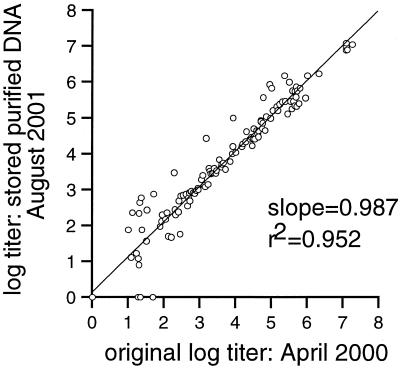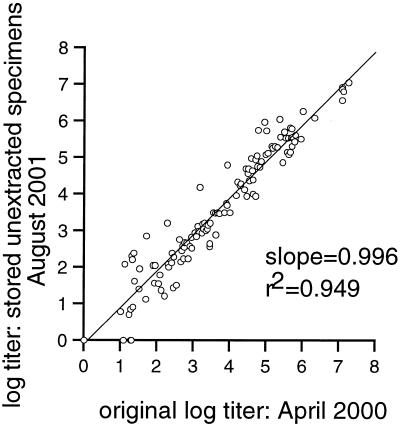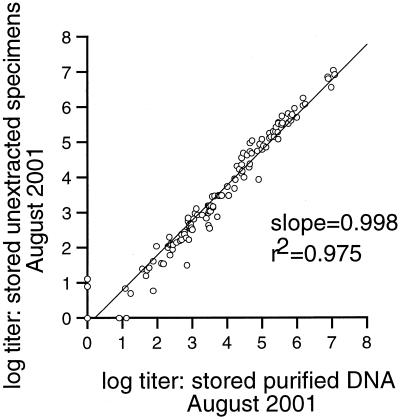Abstract
Viral DNA stored for extended periods can be amplified by PCR. However, it is unknown whether stored specimens give accurate quantitative results by newer real-time PCR techniques. We therefore compared herpes simplex virus DNA levels in specimens before and after 16 months of storage. The levels of viral DNA remained stable whether the DNA was stored as purified DNA or unextracted DNA in a whole specimen.
The PCR has proved invaluable in the diagnosis and management of viral diseases by allowing the amplification of minute quantities of viral nucleic acid in patient specimens. PCR has also been instrumental in research on these diseases. A recent advance in PCR technology has been the development of so-called real-time PCR systems. These homogeneous assays allow the rapid detection of the PCR product with a minimum of specimen handling and provide quantitative measurements of the viral nucleic acid in patient specimens.
For research purposes, PCR is often performed with specimens which have been stored for an extended period. Even in prospective studies, specimens are often stored for months or years and are then batched for a large PCR run. In addition to using laboratory resources more efficiently, such batching eliminates run-to-run variations in a PCR which might complicate interpretation of results. Several groups have reported that viral DNA stored for extended periods generally remains positive by qualitative PCR (2, 3, 8). However, it has not been investigated whether standard storage conditions retain the quantitative information on the viral DNA present in patient specimens. If storage reduces viral DNA levels as determined by PCR, it would complicate the design of studies which use archived or batched specimens. To address this issue, we performed quantitative PCR for herpes simplex virus (HSV) DNA with a large series of fresh specimens and again after 16 months of storage. Our results demonstrate that the quantitative information for stored specimens is well retained when HSV DNA levels are determined by real-time PCR.
To evaluate the accuracy of viral DNA quantitation after extended storage, we evaluated 121 HSV DNA-positive and 18 HSV DNA-negative specimens originally obtained in April 2000 from 18 human immunodeficiency virus (HIV)-infected, HSV type 2-seropositive individuals (16 men and 2 women; median age, 38 years; age range, 26 to 63 years) enrolled in a multiyear study of the natural history of HSV infection in HIV-positive persons (6). Samples were obtained by the subjects themselves with Dacron swabs, as described previously (6, 7). Secretions were obtained from cervical, vulvar, perianal, and oral sites for women and penile, perianal, and oral sites for men (cervical site, n = 11, oral site, n = 16; penile site, n = 14; perianal site, n = 86; vulvar site, n = 12). The swabs were placed in PCR medium and stored in a refrigerator. A total of 200 μl of the sample was extracted for immediate quantitation of viral DNA by real-time PCR with the TaqMan system, as described previously (5), by using the optimized gB forward primer CCG TCA GCA CCT TCA TCG A, reverse primer CGC TGG ACC TCC GTG TAG TC, and probe CCA CGA GAT CAA GGA CAG CGG CC. The remainder of the sample was frozen at −20°C, and a portion of the extracted DNA was stored at 4°C for 16 months until retesting in August 2001.
In August 2001, the stored DNA was evaluated for viral DNA levels by the same real-time PCR assay performed in April 2000. A comparison of the original quantity determined in April 2000 with the quantity from the stored purified DNA obtained in August 2001 showed a slope of 0.987, demonstrating that there was essentially no loss of viral DNA over 16 months (Fig. 1). In total, the results for 119 of 139 (86%) specimens tested in April 2000 and those tested in August 2001 agreed within 0.5 log, and the results for 128 of 139 (93%) specimens agreed within 1 log. Three specimens were negative upon retesting after storage. All three contained very low levels of virus by the original quantitation, and thus, the negative result may represent the inherent inaccuracy of quantitation of viral DNA in samples with low levels of virus rather than a true loss of viral DNA. In support of this interpretation, several specimens with low levels of viral DNA had higher levels after storage.
FIG. 1.
HSV DNA remains quantitatively stable for real-time PCR when it is stored for 16 months as purified DNA at 4°C. Dacron swab specimens were obtained in April 2000, and HSV DNA was extracted and quantitated by real-time PCR. The purified DNA was then stored for 16 months at 4°C and reanalyzed in August 2001 by a real-time PCR assay identical to the one used in April 2000.
We next evaluated the stability of viral DNA when stored in unextracted form at −20°C. After 16 months (August 2001), DNA was reextracted from 200 μl of the original specimen and the viral DNA levels were determined by the same real-time PCR used in April 2000. Regression analysis showed a slope of 0.996 (Fig. 2), demonstrating that quantitation of viral DNA is valid even when specimens are stored as whole patient specimens with unextracted DNA for 16 months. For these specimens, the results for 105 of 139 (76%) specimens tested in April 2000 and those tested in August 2001 agreed within 0.5 log, and the results for 131 of 139 (94%) specimens agreed within 1 log.
FIG. 2.
HSV DNA remains quantitatively stable for real-time PCR when stored as whole specimens with unextracted DNA for 16 months at −20°C. Dacron swab specimens were obtained in April 2000 and placed in PCR buffer. DNA was extracted from 200 μl of the buffer containing the swab specimen, and the levels of HSV DNA were analyzed by real-time PCR. The remainder of the specimen was stored for 16 months at −20°C until August 2001, and then DNA was extracted from 200 μl of the buffer containing the specimen and the levels were analyzed by a real-time PCR assay identical to the one used in April 2000.
Finally, in August 2001 we compared the quantity of HSV DNA in specimens stored as extracted DNA with the quantity of HSV DNA in the corresponding stored frozen sample. Regression analysis showed a slope of 0.998, demonstrating that there was no difference in the quantities of HSV DNA in specimens stored in the two forms (Fig. 3). By this comparison, the results for 120 of 139 (86%) specimens agreed within 0.5 log, and the results for 135 of 139 (97%) specimens agreed within 1 log.
FIG. 3.
The stability of HSV DNA is equivalent for real-time PCR when it is stored for 16 months as either purified DNA at 4°C or specimens with unextracted DNA at −20°C. Specimens were obtained in April 2000 as described in the text. The DNA was extracted and stored in purified form at 4°C, or specimens with unextracted DNA were stored for 16 months at −20°C. In August 2001 DNA was extracted from the frozen specimens and the levels of HSV DNA were compared to those from stored purified DNA by real-time PCR.
Previous work has shown that DNA stored over extended periods can be successfully amplified by PCR. Wiedbrauk and Cunningham (8) showed that HSV DNA can be amplified from cerebrospinal fluid specimens stored at temperatures ranging from 23 to −72°C over a period of 30 days. Farkas et al. (2) used purified DNA stored at 4°C for 3 years to successfully amplify the gene for factor V. However, the same group suggested that frozen swab specimens should be tested within 60 days (3). An important distinction of these earlier studies is that none used real-time detection of the PCR product, relying instead on less-sensitive qualitative detection by ethidium bromide staining of agarose gels. Even if a significant loss of viral DNA had occurred during storage, it might not have been reflected in the qualitative PCR assays used in those studies.
Our study used a real-time PCR assay to address this issue and demonstrated that HSV DNA remains quantitatively stable over at least 16 months when it is stored as unextracted DNA in a whole specimen frozen at −20°C or when it is stored at 4°C as extracted DNA. Comparison of the HSV DNA levels before and after storage showed no decreases over 16 months, and the pre- and poststorage levels showed good agreement. The quantitative information was equally well preserved whether the specimen was stored as extracted DNA or unextracted DNA in whole specimens. Presumably, these conclusions would apply for other herpesviruses and are likely to hold for other DNA viruses as well. RNA viruses are inherently less stable, and decreases in hepatitis C RNA levels after storage, as determined by the branched DNA assay (4) or end-point analysis by cDNA PCR (1), have been reported. Nevertheless, at least for herpesvirus DNA, our results confirm the validity of quantitative PCR with samples stored for extended periods.
REFERENCES
- 1.Cuypers, H. T. M., D. Bresters, I. N. Winkel, H. W. Reesink, A. J. Weiner, M. Houghton, C. L. van der Poel, and P. N. Lelie. 1992. Storage conditions of blood samples and primer selection affect the yield of cDNA polymerase chain reaction products of hepatitis C virus. J. Clin. Microbiol. 30:3220-3224. [DOI] [PMC free article] [PubMed] [Google Scholar]
- 2.Farkas, D. H., A. M. Drevon, F. L. Kiechle, R. G. DiCarlo, E. M. Heath, and D. Crisan. 1996. Specimen stability for DNA-based diagnostic testing. Diagn. Mol. Pathol. 5:227-235. [PubMed] [Google Scholar]
- 3.Farkas, D. H., K. L. Kaul, D. L. Wiedbrauk, and F. L. Kiechle. 1996. Specimen collection and storage for diagnostic molecular pathology investigation. Arch. Pathol. Lab. Med. 120:591-596. [PubMed] [Google Scholar]
- 4.Halfon, P., H. Khiri, V. Gerolami, M. Bourliere, J. M. Feryn, P. Peynier, A. Gauthier, and G. Cartouzou. 1996. Impact of various handling and storage conditions on quantitative detection of hepatitis C virus RNA. J. Hepatol. 25:307-311. [DOI] [PubMed] [Google Scholar]
- 5.Ryncarz, A. J., J. Goddard, A. Wald, M.-L. Huang, B. Roizman, and L. Corey. 1999. Development of a high-throughput quantitative assay for detecting herpes simplex virus DNA in clinical samples. J. Clin. Microbiol. 37:1941-1947. [DOI] [PMC free article] [PubMed] [Google Scholar]
- 6.Schacker, T., J. Zeh, H.-L. Hu, E. Hill, and L. Corey. 1998. Frequency of symptomatic and asymptomatic herpes simplex virus type 2 reactivations among human immunodeficiency virus-infected men. J. Infect. Dis. 178:1616-1622. [DOI] [PubMed] [Google Scholar]
- 7.Wald, A., J. Zeh, S. Selke, R. L. Ashley, and L. Corey. 1995. Virologic characteristics of subclinical and symptomatic genital herpes infections. N. Engl. J. Med. 333:770-775. [DOI] [PubMed] [Google Scholar]
- 8.Wiedbrauk, D. L., and W. Cunningham. 1996. Stability of herpes simplex virus DNA in cerebrospinal fluid specimens. Diagn. Mol. Pathol. 5:249-252. [DOI] [PubMed] [Google Scholar]





